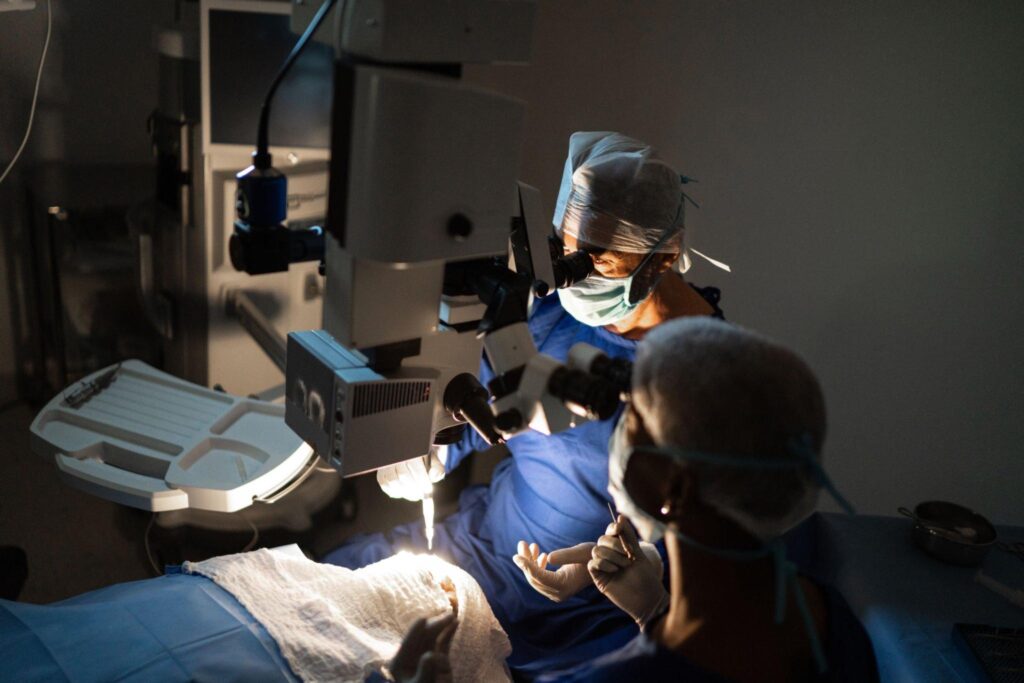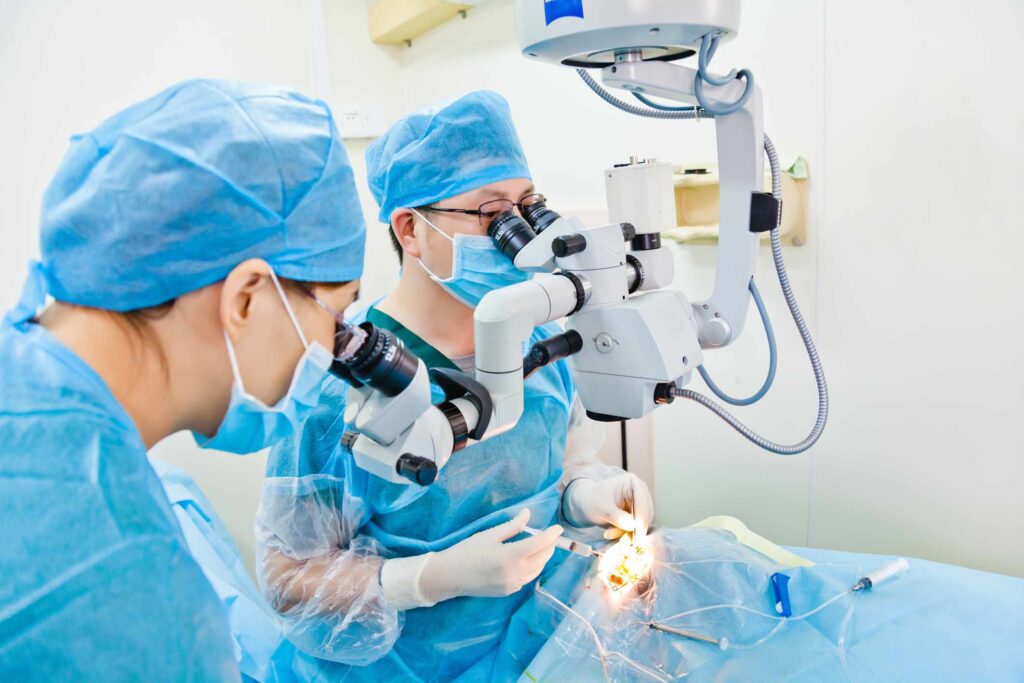LASIK eye surgery is a common procedure that can correct vision problems such as nearsightedness, farsightedness, and astigmatism. Despite its popularity, there are still many myths and misconceptions surrounding this type of surgery. In this article, we will debunk these myths and provide you with accurate information about LASIK eye surgery.
Understanding LASIK Eye Surgery
What is LASIK Eye Surgery?
LASIK stands for Laser-Assisted In Situ Keratomileusis. It is a refractive surgical procedure that reshapes the cornea to improve vision. During the surgery, a laser is used to create a thin, circular flap in the outer layer of the cornea. The flap is then folded back, and the underlying corneal tissue is reshaped using another laser. The flap is then repositioned, and it adheres back into place naturally.
LASIK eye surgery is typically performed on both eyes on the same day, and the procedure itself takes only about 15 minutes per eye. Most patients experience improved vision almost immediately after the LASIK eye surgery, with full results usually achieved within a few weeks.
The Procedure of LASIK Surgery
The LASIK procedure involves several steps. First, your surgeon will administer eye drops to numb your eyes. Then, a device called a microkeratome or a femtosecond laser is used to create the corneal flap. The flap is carefully lifted, and the laser is used to remove a small amount of corneal tissue to reshape the lens. Finally, the flap is repositioned, and it adheres naturally without the need for stitches.

The entire LASIK procedure is virtually painless, as numbing eye drops are used to ensure your comfort throughout the surgery. Some patients may experience mild discomfort or a scratchy sensation for a day or two after the surgery, but this can be managed with over-the-counter pain relievers and eye drops prescribed by your surgeon. Learn more recovery tips after cataract surgery.
It is important to note that LASIK surgery is a highly precise and individualized procedure. Before undergoing LASIK, you will have a comprehensive eye examination to determine your eligibility for the surgery. Your surgeon will assess factors such as the thickness of your cornea, the shape of your eye, and the overall health of your eyes. This thorough evaluation ensures that LASIK is the right choice for you and that the procedure can be tailored to meet your specific needs.
During the LASIK surgery, your surgeon will use advanced technology to precisely reshape your cornea, correcting any refractive errors such as nearsightedness, farsightedness, or astigmatism. The laser used in the procedure is guided by a computer, ensuring accuracy and minimizing the risk of complications. The corneal flap created during the surgery acts as a natural bandage, promoting faster healing and reducing discomfort.
After the LASIK surgery, it is important to follow your surgeon’s post-operative instructions carefully. This may include using prescribed eye drops to prevent infection and inflammation, avoiding activities that may strain your eyes, and attending follow-up appointments to monitor your progress. Your surgeon will provide you with detailed guidelines to ensure a smooth recovery and optimal results.
Common Myths About LASIK Eye Surgery
There are several misconceptions surrounding LASIK eye surgery that can deter individuals from considering this life-changing procedure. Let’s delve deeper into some of the common myths associated with LASIK to provide a clearer understanding of the facts.
Myth 1: LASIK Surgery is Painful
Contrary to popular belief, LASIK surgery is not a painful procedure. The idea of having a laser reshape your cornea may sound daunting, but in reality, patients experience minimal to no discomfort during the surgery. Numbing eye drops are administered beforehand to ensure a painless experience. Any sensations felt during the surgery are typically described as pressure or mild discomfort rather than pain. After the procedure, some individuals may experience a temporary scratchy sensation, but this can be easily managed with over-the-counter pain relievers and typically subsides quickly.
Myth 2: LASIK Results are Temporary
One of the most enduring myths about LASIK is that the results are temporary. In fact, LASIK surgery provides long-lasting vision correction. The corneal reshaping that occurs during the procedure is permanent, offering patients the potential for clear vision without the need for glasses or contacts. While it’s true that certain factors such as age, existing eye conditions, and natural aging can impact vision over time, the fundamental changes made to the cornea through LASIK remain stable. In some cases, individuals may require glasses for specific tasks like reading or driving as they age, but the overall benefits of LASIK are considered enduring.
Myth 3: LASIK is Not Safe
Concerns about the safety of LASIK surgery are unfounded, as it is a well-established and FDA-approved procedure. Millions of individuals worldwide have undergone LASIK with exceptional results and satisfaction. Like any surgical intervention, there are potential risks and complications associated with LASIK, but these occurrences are rare and typically minor. Selecting a skilled and experienced surgeon is crucial in minimizing any potential risks and ensuring a successful outcome. By choosing a reputable eye care provider and following post-operative care instructions diligently, patients can confidently undergo LASIK with a high degree of safety and efficacy.
The Reality Behind the Myths
The Truth About LASIK Pain
LASIK surgery is a painless procedure. The use of numbing eye drops before the surgery ensures that patients do not experience any pain during the procedure. Some patients may feel mild discomfort or a scratchy sensation for a day or two after the surgery, but this is temporary and can be easily managed.
The vast majority of LASIK patients report minimal discomfort during their recovery period, and any discomfort is typically alleviated with the use of prescribed eye drops and over-the-counter pain relievers.
During the LASIK procedure, a small flap is created on the surface of the cornea, allowing the surgeon to reshape the underlying tissue. This precise reshaping corrects refractive errors, such as nearsightedness, farsightedness, and astigmatism. The entire process is completed within minutes, and patients are often amazed at the immediate improvement in their vision.
After the surgery, it is common for patients to experience a temporary increase in sensitivity to light and a slight blurring of vision. However, these side effects typically subside within a few days as the eyes heal and adjust to their new shape.
The Longevity of LASIK Results
The results of LASIK eye surgery are long-lasting. While it is true that certain factors such as aging or pre-existing eye conditions can affect vision over time, the corneal reshaping achieved during LASIK is permanent. In most cases, patients experience a significant improvement in their vision that lasts for many years, if not a lifetime.
It is important to follow the post-operative care instructions provided by your surgeon to ensure optimal results and maintain the longevity of your LASIK outcomes.
It is worth noting that some patients may require a touch-up procedure, known as an enhancement, to further refine their vision. Enhancements are typically performed months or even years after the initial LASIK surgery, and they are highly effective in fine-tuning the results.
With advancements in technology and surgical techniques, LASIK has become even more precise and customizable. Surgeons can now tailor the procedure to address individualized vision needs, ensuring that patients achieve the best possible outcomes.
The Safety of LASIK Procedures
LASIK eye surgery is a safe and well-established procedure. The technology and techniques used in LASIK have significantly evolved over the years, making it a highly precise and predictable surgery. The risk of severe complications is extremely low, and the vast majority of patients achieve excellent visual outcomes without encountering any significant problems.
As with any surgery, there are risks involved, such as dry eyes, halos, or glare, but these are usually temporary and resolve over time. It is crucial to undergo a thorough examination and consultation with an experienced LASIK surgeon to determine if you are a suitable candidate and to discuss any potential risks specific to your individual circumstances.
During the LASIK procedure, advanced technologies, such as wavefront-guided laser systems, are used to map the unique characteristics of each patient’s eye. This personalized approach allows for precise and accurate corneal reshaping, minimizing the risk of complications and maximizing visual outcomes.
Furthermore, LASIK surgeons undergo extensive training and certification to ensure the highest level of safety and proficiency. They work closely with their patients to thoroughly evaluate their eye health, discuss expectations, and provide comprehensive pre-operative and post-operative care.

Making an Informed Decision About LASIK
Factors to Consider Before LASIK
Before making a decision about LASIK eye surgery, it is essential to consider certain factors. Factors such as your age, overall eye health, and any pre-existing eye conditions should be taken into account. Your LASIK surgeon will conduct a comprehensive evaluation to determine if you are a suitable candidate for the procedure.
Other factors to consider include your lifestyle, occupation, and expectations from the surgery. It is important to have realistic expectations and a clear understanding of the potential benefits and limitations of LASIK surgery.
Questions to Ask Your Surgeon
When considering LASIK surgery, it is crucial to ask your surgeon any questions or concerns you may have. Some questions you might consider asking include:
- What are the potential risks and complications of LASIK?
- What is the success rate of LASIK?
- How long is the recovery period?
- What are the alternatives to LASIK?
- How many LASIK surgeries have you performed?
Your surgeon will provide you with detailed information and address any specific concerns you may have, helping you make an informed decision about LASIK eye surgery.
The Impact of LASIK on Quality of Life
Improvements in Vision Post-LASIK
LASIK eye surgery can have a significant positive impact on an individual’s quality of life. After the surgery, patients often experience improved vision, reducing their dependency on glasses or contact lenses. The enhanced visual clarity and freedom from corrective eyewear can lead to increased confidence and better overall visual experiences.
It is important to note that while LASIK can correct most common refractive errors, there is no guarantee of achieving perfect vision. It is vital to have realistic expectations and understand that LASIK does not eliminate the need for reading glasses in individuals over the age of 40, as presbyopia is a natural age-related condition.
Lifestyle Changes After LASIK Surgery
Following LASIK surgery, many patients find that their lifestyle improves. Activities such as swimming, playing sports, or traveling become more convenient without the need for glasses or contact lenses. Additionally, the elimination of contact lenses reduces the risk of eye infections or discomfort associated with wearing contacts.
It is important to note that rigorous physical activities should be avoided for a short period after LASIK surgery, as recommended by your surgeon. It is also crucial to follow post-operative care instructions to ensure optimal healing and minimize any potential risks.
In conclusion, LASIK eye surgery is a safe and effective procedure for correcting vision problems. The myths surrounding LASIK, such as the belief that it is painful, temporary, or unsafe, have been debunked. While there are risks associated with any surgery, LASIK has a high success rate and has provided millions of individuals with improved vision and a better quality of life. By understanding the facts and making an informed decision, you can confidently consider LASIK eye surgery as an option to enhance your visual clarity and reduce your dependence on corrective eyewear.

